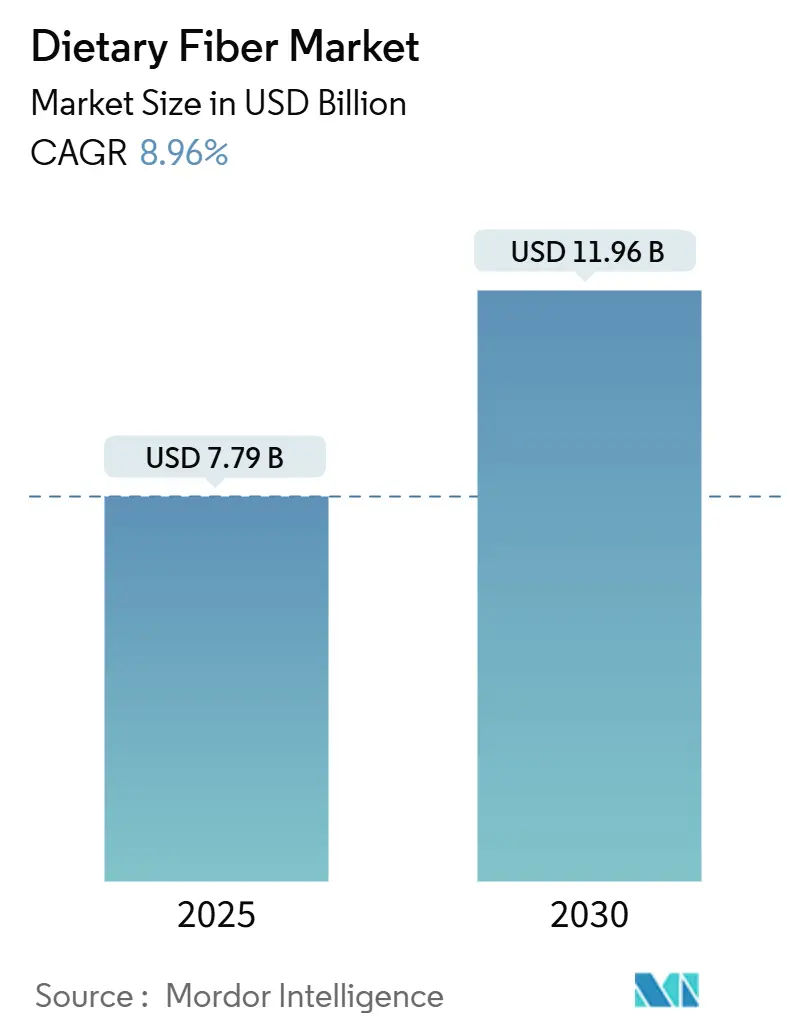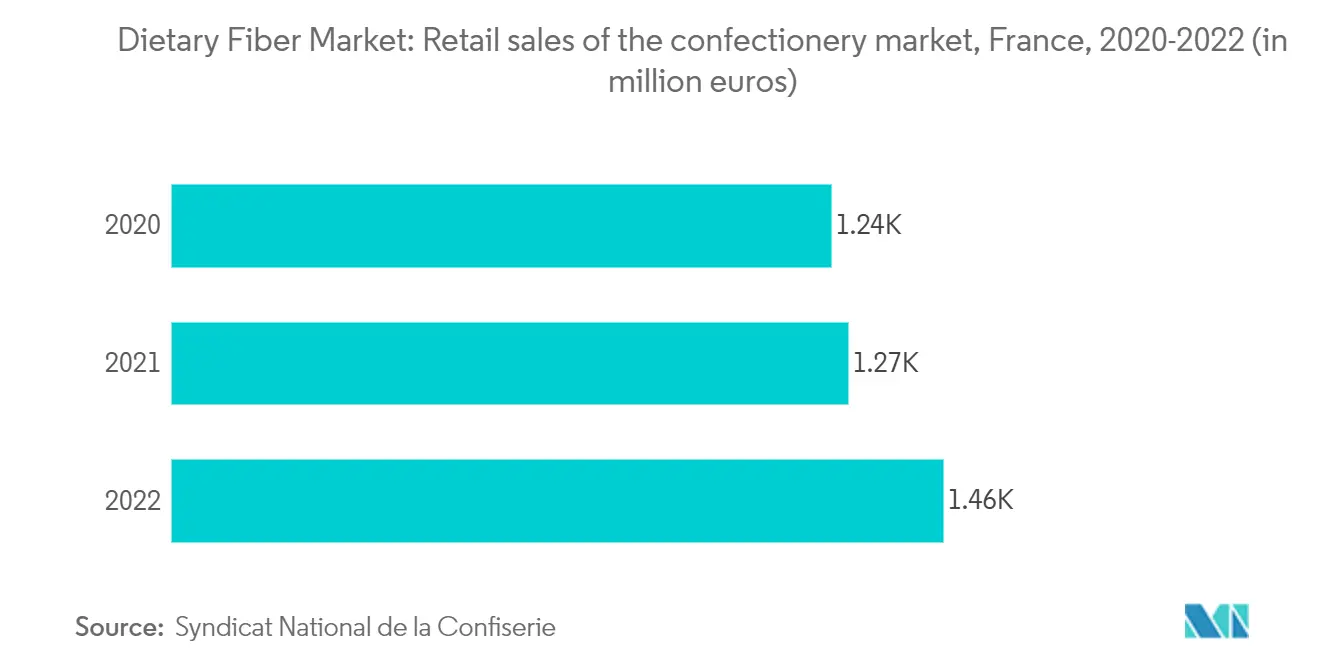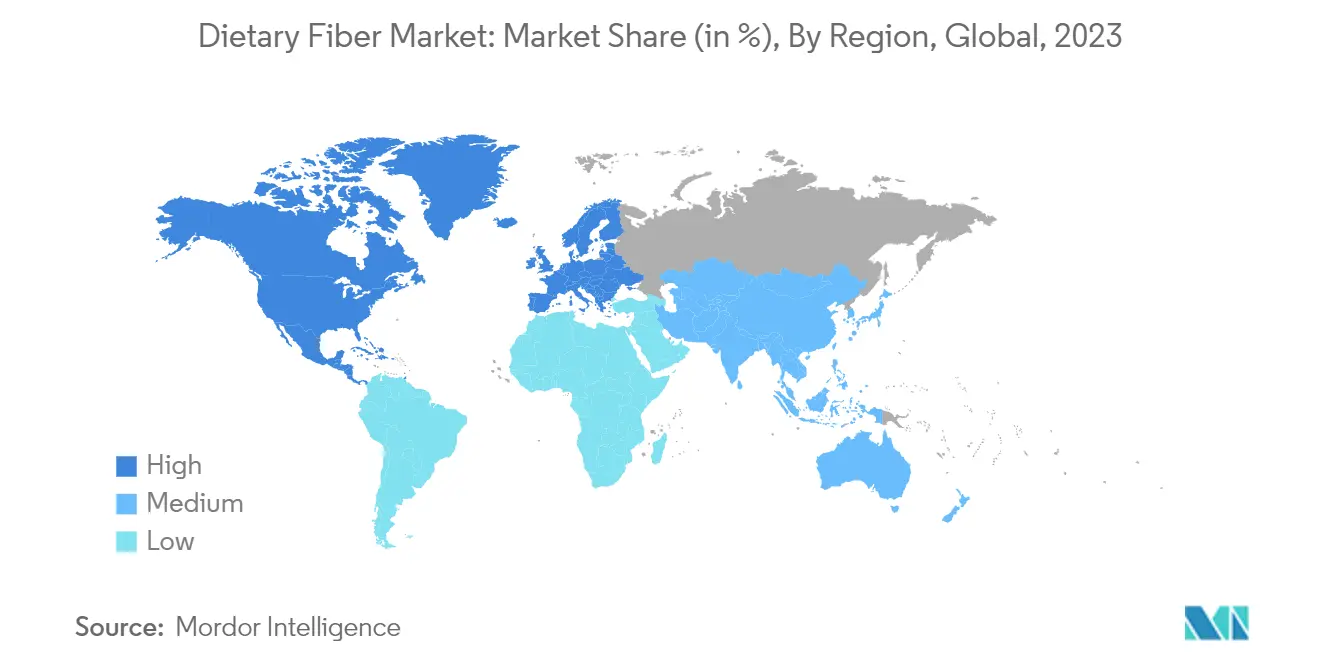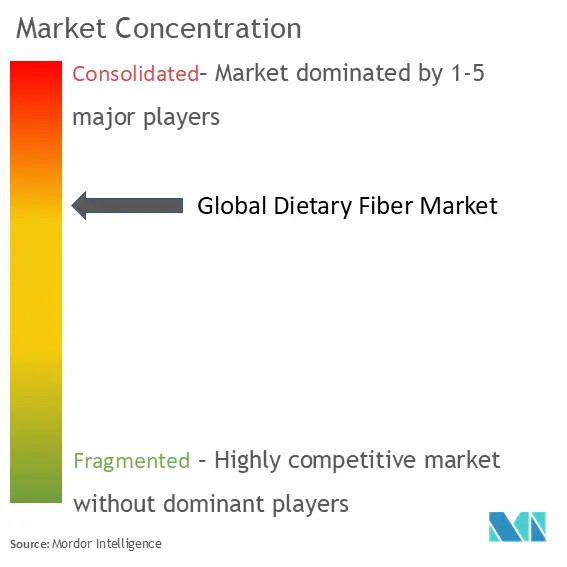Dietary Fiber Market Analysis
The Dietary Fiber Market size is estimated at USD 7.79 billion in 2025, and is expected to reach USD 11.96 billion by 2030, at a CAGR of 8.96% during the forecast period (2025-2030).
The dietary fiber market is experiencing significant growth, driven by the increasing awareness of the health benefits associated with dietary fiber consumption. Consumers are becoming more health-conscious, leading to a rise in demand for products enriched with dietary fibers. This demand is particularly evident in the food and beverage sector, where dietary fibers are increasingly being incorporated into functional foods, beverages, and other health-oriented products.
Applications of Dietary Fiber
- Functional Foods and Beverages: Dietary fibers are widely utilized in functional foods and beverages, dairy, bakery, and confectionery products. These applications highlight the versatility of dietary fibers, which are known for their ability to improve digestive health, manage blood sugar levels, and contribute to overall wellness. The market segmentation further reveals a significant distinction between soluble and insoluble fibers, each offering unique health benefits and applications. Soluble fibers are gaining traction for their role in reducing cholesterol levels and improving heart health, while insoluble fibers are essential for promoting regular bowel movements and preventing constipation.
- Diverse Sourcing: Dietary fibers are sourced from a variety of foods, including vegetables, fruits, grains, and cereals. This diverse sourcing is essential for meeting the growing consumer demand for natural and health-promoting ingredients. The dietary fiber market is also witnessing innovation in product development, with companies focusing on enhancing the nutritional profile and functionality of fibers used in various food products.
Rising Demand for Functional Fiber Products
- Health-Conscious Consumer Trends: The demand for functional fiber products is growing as consumers increasingly seek foods that offer health benefits beyond basic nutrition. Functional foods and beverages, which are fortified with dietary fibers, are gaining popularity due to their ability to support digestive health, manage weight, and reduce the risk of chronic diseases. This trend is especially prominent in regions like North America and Europe, where health and wellness are prioritized in dietary choices. The global dietary fiber market is also benefiting from the rising awareness of the role of fiber in managing chronic conditions such as obesity and diabetes.
- Bakery and Confectionery Innovations: The bakery and confectionery segment is another area where dietary fibers are making a significant impact. Manufacturers are incorporating fibers into these products to enhance their nutritional value without compromising taste. This approach appeals to health-conscious consumers who are looking for indulgent yet healthy options. Moreover, the growing trend of clean-label products is driving manufacturers to use natural sources of dietary fibers, which resonate well with consumers seeking transparency in food ingredients.
- Advancements in Extraction Technologies: Additionally, the industry is seeing advancements in the extraction and processing of dietary fibers from various sources. New technologies are enabling the production of high-purity fibers with enhanced solubility and stability, making them suitable for a broader range of food applications. This is particularly important in the growing market for plant-based and vegan products, where dietary fibers play a crucial role in mimicking the texture and mouthfeel of traditional animal-based products.
Innovations in Dietary Fiber Product Development
- Product Development and R&D: Innovation in dietary fiber product development is a key factor contributing to the market's growth. Companies are investing in research and development to create fibers that are not only functional but also versatile in their application. For example, the development of soluble fibers that can be easily incorporated into beverages without altering taste or texture has opened up new opportunities in the functional beverage market. These innovations are helping manufacturers cater to the evolving needs of consumers who are looking for convenient ways to increase their fiber intake.
Dietary Fiber Market Trends
Increased Demand in the Bakery and Confectionery Segment
With the surge in health consciousness, consumers are increasingly seeking dietary fibers in bakery and confectionery products. These fibers, known for improving digestive health and lowering chronic disease risks, are now key ingredients in bread, cakes, and chocolates. This shift in consumer behavior is fueling the growth of the global dietary fiber market, especially within this segment, as manufacturers innovate to meet this demand.
- Technological Innovations: Advances in food technology have facilitated the integration of functional fibers into bakery products without compromising quality. These fibers enhance the nutritional profile, improve texture, and extend the shelf life of baked goods. For instance, soluble fibers are being widely used for their ability to dissolve in water, forming a gel-like consistency that benefits product quality, driving the soluble fiber market trends.
- Economic Benefits: The ability of dietary fibers to retain moisture and prolong the freshness of bakery products is reducing economic losses for manufacturers. By replacing unhealthy fats and additives with dietary fibers, companies can offer healthier alternatives that align with the growing wellness trend, contributing to the dietary fiber market's expansion.
- Growth Projections: The dietary fiber industry outlook remains positive, with forecasts predicting continued growth driven by consumer demand for fiber-enriched bakery and confectionery products. As the global dietary fiber market size increases, this segment is expected to be a significant contributor, reflecting broader dietary fiber market trends.
Europe Is The Fastest Growing Market For Dietary Fibers
- Health-Driven Growth: Europe has emerged as the fastest-growing dietary fiber market, propelled by rising consumer awareness and health benefits associated with dietary fibers. The market is experiencing growth due to increasing cases of heart diseases, type 2 diabetes, and obesity, prompting consumers to adopt high-fiber diets. This trend is particularly strong in functional foods and beverages, which are gaining popularity across the region.
- Regulatory Support: The European Food Safety Authority (EFSA) plays a crucial role in the dietary fiber industry's growth by promoting the inclusion of dietary fibers in food products. This regulatory backing supports market leaders and new entrants, fostering a dynamic environment for the dietary fiber market's expansion in Europe.
- Diverse Fiber Sources: The European dietary fiber market is characterized by a wide range of fiber sources, including cereals, fruits, vegetables, and legumes. Countries like Germany, France, and the United Kingdom dominate the market, driven by high consumption of fiber-rich foods. The focus on organic and clean-label products is also contributing to market growth, reflecting evolving dietary fiber consumption patterns.
- Innovation and Investment: Significant investments in research and development are leading to the introduction of novel dietary fiber products in Europe. These innovations are enhancing the overall market value, with predictions indicating sustained growth in the dietary fiber industry. As consumer demand continues to rise, the market forecast for Europe remains optimistic, underscoring its role as a key player in the global dietary fiber market.
Dietary Fiber Industry Overview
- Consolidated Market with Global Conglomerates: The global dietary fiber market is characterized by a consolidated structure, where a small number of large multinational companies dominate the landscape. These players, primarily conglomerates with diverse product portfolios, leverage their extensive resources and global presence to maintain significant market shares. The consolidation is driven by the need for advanced research capabilities, stringent quality control, and large-scale production facilities that smaller players struggle to match.
- Market Leaders Driving Innovation and Expansion: The key players leading the dietary fiber market include ADM, Cargill, DuPont, Tate & Lyle, and Ingredion. These companies stand out due to their strong R&D investments, enabling them to innovate and develop high-quality, differentiated products that cater to the growing consumer demand for health-conscious dietary solutions. Their global distribution networks and strategic partnerships further enhance their market leadership, allowing them to tap into emerging markets effectively.
- Trends and Strategies for Future Success: Major trends influencing the dietary fiber market include the increasing consumer awareness of gut health and the rising demand for functional foods. To succeed, companies need to focus on clean-label products, sustainability, and expanding their product lines to include novel fibers with added health benefits. Strategic acquisitions and collaborations are also vital for companies to enhance their market positions and innovate in response to evolving consumer preferences.
Dietary Fiber Market Leaders
-
ADM
-
Cargill
-
DuPont
-
Tate and Lyle
-
Ingredion
- *Disclaimer: Major Players sorted in no particular order
Dietary Fiber Market News
- December 2023: Equii, known for its 'complete' protein bread, launched its latest offerings: Complete Protein and Added Fiber breads. These new variants come in two flavors: Premium Classic Wheat + Fiber and Premium Multi-Grain + Fiber. As per the company's claims, each slice of these breads packs in 4 grams of dietary fiber and 8 grams of protein.
- May 2023: Nestlé Health Science has introduced Resource Fiber Choice, a gut health product featuring Partially Hydrolyzed Guar Gum (PHGG). Derived from naturally sourced guar gum beans, PHGG is a prebiotic dietary fiber that aids in alleviating constipation and enhancing gut health.
- October 2022: Brightseed, a pioneer in bioactive discovery, unveiled Brightseed Bio 01, an innovative dietary hemp fiber designed to bolster gut health, specifically tailored for food and beverage applications. Derived from upcycled hemp hulls and crafted to enhance its bioactive properties, Brightseed Bio 01 stands out as the sole dietary fiber in the market, boasting two bioactive compounds. These compounds have demonstrated potential in preclinical studies to fortify gut barrier integrity.
Dietary Fiber Industry Segmentation
The global dietary fiber market is segmented by application into bakery and confectionery, functional food, functional beverage, dairy and others. By product type, the market is divided into soluble and insoluble. By source, the market is segmented into vegetables, fruits, grains and cereals and others. The geographical analysis of the market includes developed and emerging regions, primarily North America, Europe, Asia Pacific, South America, And the Middle East And Africa. The market sizing has been done in value terms in USD for all the abovementioned segments.
| By Application | Functional Food | ||
| Functional Beverages | |||
| Dairy | |||
| Bakery & Confectionary | |||
| Others | |||
| By Product Type | Soluble | ||
| Insoluble | |||
| By Source | Vegetables | ||
| Fruits | |||
| Grains & Cereals | |||
| Others | |||
| Geography | North America | United States | |
| Canada | |||
| Mexico | |||
| Rest of North America | |||
| Europe | United Kingdom | ||
| France | |||
| Germany | |||
| Italy | |||
| Russia | |||
| Spain | |||
| Rest of Europe | |||
| Asia Pacific | China | ||
| Japan | |||
| Australia | |||
| India | |||
| Rest of Asia Pacific | |||
| South America | Brazil | ||
| Argentina | |||
| Rest of South America | |||
| Middle East & Africa | Saudi Arabia | ||
| South Africa | |||
| Rest of Middle East & Africa | |||
Dietary Fiber Market Research FAQs
How big is the Dietary Fiber Market?
The Dietary Fiber Market size is expected to reach USD 7.79 billion in 2025 and grow at a CAGR of 8.96% to reach USD 11.96 billion by 2030.
What is the current Dietary Fiber Market size?
In 2025, the Dietary Fiber Market size is expected to reach USD 7.79 billion.
Who are the key players in Dietary Fiber Market?
ADM, Cargill, DuPont, Tate and Lyle and Ingredion are the major companies operating in the Dietary Fiber Market.
Which is the fastest growing region in Dietary Fiber Market?
Europe is estimated to grow at the highest CAGR over the forecast period (2025-2030).
Which region has the biggest share in Dietary Fiber Market?
In 2025, the North America accounts for the largest market share in Dietary Fiber Market.
What years does this Dietary Fiber Market cover, and what was the market size in 2024?
In 2024, the Dietary Fiber Market size was estimated at USD 7.09 billion. The report covers the Dietary Fiber Market historical market size for years: 2019, 2020, 2021, 2022, 2023 and 2024. The report also forecasts the Dietary Fiber Market size for years: 2025, 2026, 2027, 2028, 2029 and 2030.
Our Best Selling Reports
Dietary Fiber Industry Report
Our industry research delves deep into the dietary fiber market, providing comprehensive insights into current trends, consumer behavior, and product innovations. The report covers crucial aspects such as dietary fiber applications, market segmentation, and the role of soluble and insoluble fibers in driving market growth. With an emphasis on health-conscious consumer trends and the rising demand for functional fiber products, the report offers valuable industry information for stakeholders looking to navigate the evolving market landscape. This detailed analysis is presented in an easy-to-read report pdf format, ensuring that all the key market data is accessible and actionable.
Stakeholders will benefit from the dietary fiber market research as it covers the latest industry trends and forecasts, including the growth of the functional foods and beverages segment. The report highlights the advancements in dietary fiber extraction technologies and the innovations in product development, which are pivotal in enhancing market value. Additionally, the analysis of regional markets, such as the fast-growing European dietary fiber market, offers a thorough industry overview that helps businesses identify opportunities for expansion. The industry report pdf is an essential tool for understanding market dynamics, aiding in strategic decision-making and long-term planning.
Statistics for the 2024 Dietary Fiber market share, size and revenue growth rate, created by Mordor Intelligence™ Industry Reports. Dietary Fiber analysis includes a market forecast outlook to 2029 and historical overview. Get a sample of this industry analysis as a free report PDF download.

.webp)





